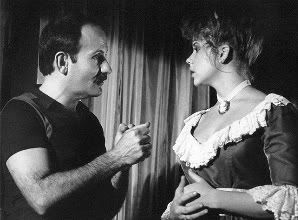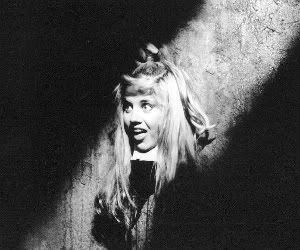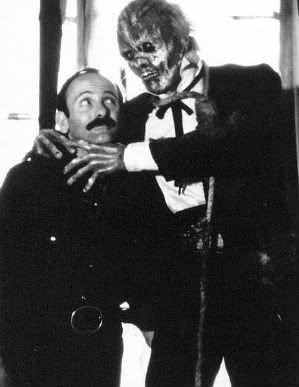
How did you first start out in the industry and what kind of projects did you work on before you moved onto horror? What do you remember of your little seen movie Chatterbox?
“It was always my goal, even as a child, to make movies. I started making 8mm films when I was ten and continued on all through high school. Mostly using friends, family and table-top models for my projects. It was always my intention, if I would be so lucky, to go to California and work in films. After getting my Masters in Motion Picture Production at UCLA I worked at various companies making educational films and shorts. Mostly as an editor. My first real mainstream movie was Chatterbox. I had an old story outline for an X-rated comedy called Lips. A producer saw it, liked it and we joined forces and it became Chatterbox. American International did the theatrical releases.”
Were you a fan of horror growing up and which stories or films made the greatest impression on you?
“When I was very young the old Universal Horror films, Frankenstein and Dracula or Wolfman always remained in my memory as fun scares. Then in college the Hammer films from England were campy fun.”
How did Hell Night come about? What was your opinion on the other slasher movies that had been released at that time (Halloween, Friday the 13th) and how would you compare your film to those?
“The same producer who did Chatterbox, Bruce Curtis, was a friend of Linda Blair. They worked together on Born Innocent, a TV movie she did for him about girls in the lock up. He came across the script for Hell Night, talked her into doing it and then contacted me. We always said we wanted to work together again after Chatterbox. We didn’t want to make a carbon copy of all the other slasher films at that time. We hoped to come up with something different. Linda didn’t want to do just blood and gore, and niether did I.”

Was the idea of fancy dress a concept you had in mind from the beginning and was this an attempt to distance Hell Night from the usual stalk and slasher formula by including gothic overtones?
“I wanted them to be dressed in period costumes so that the film would have a more “classic” horror feel, like the old Hammer Horror films. I didn’t want them wandering an old haunted house with candles and cobwebs dressed in jeans and T-shirts.”
Were you intending on creating an iconic villain, such as Halloween’s Michael Myers or The Texas Chainsaw Massacre’s Leatherface, or did you always intend on keeping the monster in the shadows? Most of the popular slashers have become successful due to a recognisable and marketable bogeyman, did you always hope for your antagonist(s) to remain elusive?
“We never thought of creating a re-usable monster. Maybe we should have, but at the time the script was what it was and I shot it.”
As Hell Night was produced by Irwin Yablans, were you ever under pressure to cash in on his previous hit, Halloween, and how much creative freedom were you given?
“I never saw any of the Halloween series, believe it or not. The producer, Irwin Yablans, had produced the original Halloween and he was one of the producers on Hell Night. There was never any pressure to compete or copy any of Halloween’s style. He was very supportive and even worked along side the writer and myself in making some changes to the script.”
Was it a conscious decision to feature mostly bloodless killings or was this due to the strict demands of the MPAA?
“We talked early on about making the film more of a suspense film rather than a slasher movie. There was one scene, a favorite of mine, which was quite gory but we had to trim it down. The scene where Jenny gets her head chopped off. It was supposed to play as follows: The monster was to grab her hair, pull her up against the wall, swing the blade and cut her head off…but instead of her head falling off, as in most horror films, I wanted the body to drop out of frame and see her head still in his hand, with here eyes open and her mouth screaming. We rigged a special wall where she could put her head through a hole and then we put a fake body up under it. We attached her neck to the dummy using mortician’s wax to look real and to make it easy to cut. She had to lay on her stomach on a long board behind the wall with her head sticking out. But she had to hold her head up, through that hole, for a long time while we rigged the body and made the neck. She was very uncomfortable. Then we had to practice the blade swing to be sure her face wouldn’t get hit. It was a long, slow process and very painful for her. Finally we got it done perfectly and it played just great. I was a shocking scene. Unfortunately, when the censors saw it they said it was just too gruesome and it may have lost us the ratings… so we had to cut it. Now in the film, as soon as the blade hits her neck, the scene cuts away and you never see the body fall and her living head still screaming. It was a big disappointment to me. Today that would be mild compared to what’s happening on screen now.”

At what stage during filming was the script stolen and how did you overcome this major obstacle? Was the script ever recovered and how different was the finished movie to your original intentions due to this incident?
“During the first week of the shoot, some bystander stole my director’s script and all my directing notes, etc. were gone. I had to work each night at the hotel to try to redo all my notes and diagrams and charts and stuff. We put up signs asking for it, offered a reward and other incentives but it was never recovered. I don’t recall any changes from my first notes to my final production. After several months of prep, you pretty much have the film all shot in your head anyway. After that happened we closed the sets to all bystanders. No one was allowed to get near the working area after that. Then the town began to get annoyed with the commotion and the crowds that came each night and we were pretty much asked to get done and get out of there.”
As the movie was set over one night, how difficult was it to keep continuity and were you concerned that shooting only night scenes in an old mansion could have made the film to dark and gloomy?
“We shot in November and December and all the night exteriors around the mansion were done in Redlands, CA. It was a long tedious four weeks of cold, damp nights. Work was slow because of the weather and the actors were wearing fairly skimpy costumes and not well dressed for damp nights. The interiors of the mansion were done somewhere else, in Pasadena in an old home we stripped bare and filled with cobwebs and candles. The tunnels under the house and the rooftop were sets on a soundstage in Hollywood at Raleigh studios. We ended up shooting four weeks in Redlands – all night exteriors. Then two weeks in the house for all the mansion interiors and the final two weeks on the stage doing the tunnels, the roof and one bedroom where the monster comes up through the floor. Mac Ahlberg, the cinematographer, and I discussed the look we wanted and it was deliberate that we had only the look of firelight and candles. We wanted that soft glow and warm light throughout. On screen the film is stunningly gorgeous. Some VHS copies are murky or too dark because of bad transfers. I think the DVD is a lot better….but nothing compares to a good print on a big screen, trust me!”
How come you chose to cast Linda Blair as the lead and was she easy to work with? Much of the supporting cast were inexperienced, were you pleased with their performances and do you feel that you managed to avoid the usual teen horror clichés?
“There was NO audition for Linda. She came with the deal. If she wasn’t in it, there wouldn’t have been a film. We had Linda locked in and agents sent out other players. Bruce, the producer, wanted to work with Vince Van Patten so he called him in. Peter Barton was suggested by his agent and we read him and liked him as well. All the others were auditioned and got their parts based on their ability. I was pretty much please with most of the work done. It’s been years now, so I can’t recall any performances that made me unhappy at the time. Some, not all, were difficult at times but the conditions were testy as well.”
How well was Hell Night received when it was first released and was it considered a financial success? Was there ever talk of a sequel and, if so, would you have returned?
“Hell Night didn’t cause any sensation at first but it grew as a cult film in time. It did out-gross Jaws when it opened in Japan. I believe they were big fans of Linda’s there so it helped. The film made money, of course, but it wasn’t what we now call a blockbuster. It was a small film so making good money then was easier than it would be today.”
With so many slashers being remake these days a new Hell Night is inevitable. Have you been approached regarding this or have you heard any rumours and would you consider returning to the movie almost thirty years later?
“There has been talk for years about a sequel from the same producer, Bruce Cohn Curtis. But niether Linda nor I would probably be involved after all this time.”

INTERVIEW: Christian Sellers

7 Responses to Tom DeSimone (director; Hell Night)